Our regular reviewer Brian Robins has just posted a video on YouTube, ‘Toward a Greater Understanding of Baroque Opera’ – highly recommended for all lovers of the genre and readers of his reviews.
Click this link to watch the video:
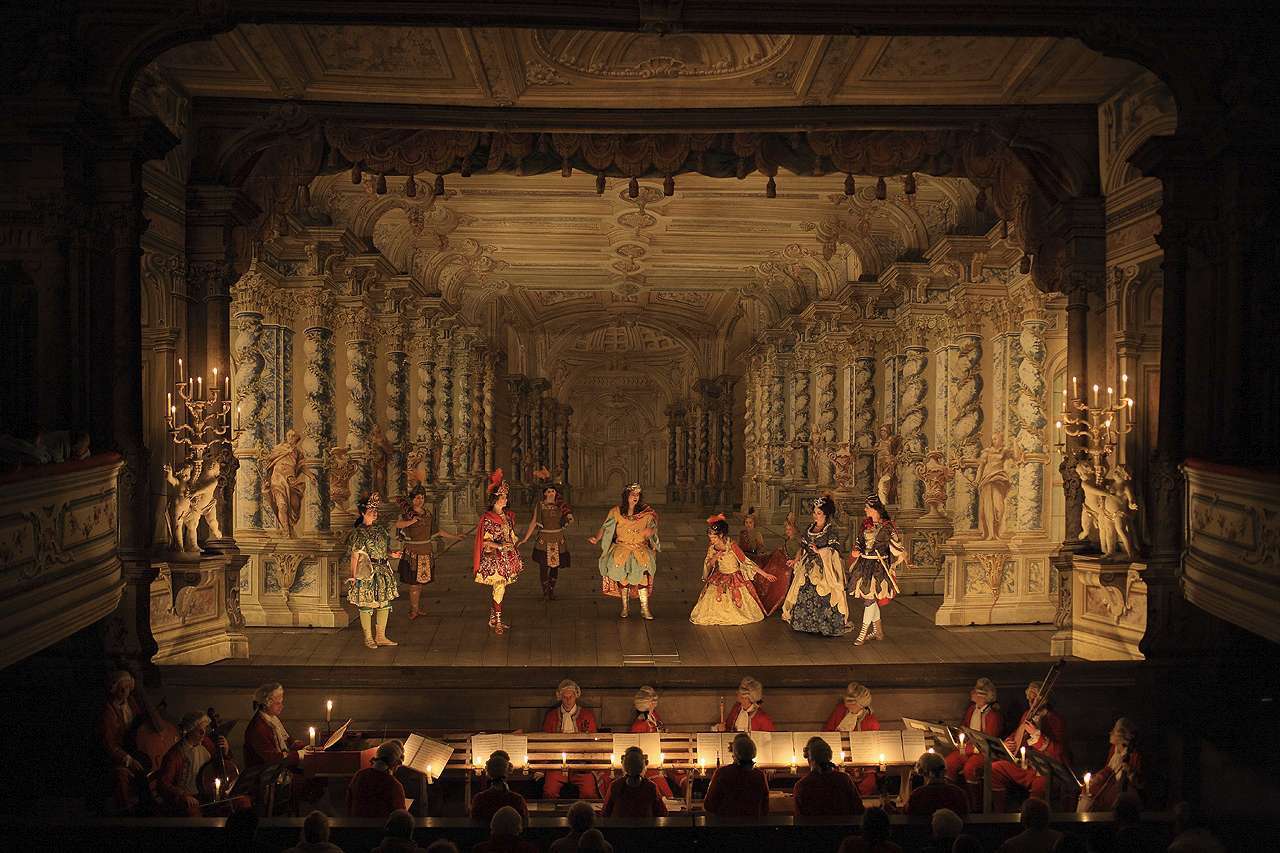
Our regular reviewer Brian Robins has just posted a video on YouTube, ‘Toward a Greater Understanding of Baroque Opera’ – highly recommended for all lovers of the genre and readers of his reviews.
Click this link to watch the video:
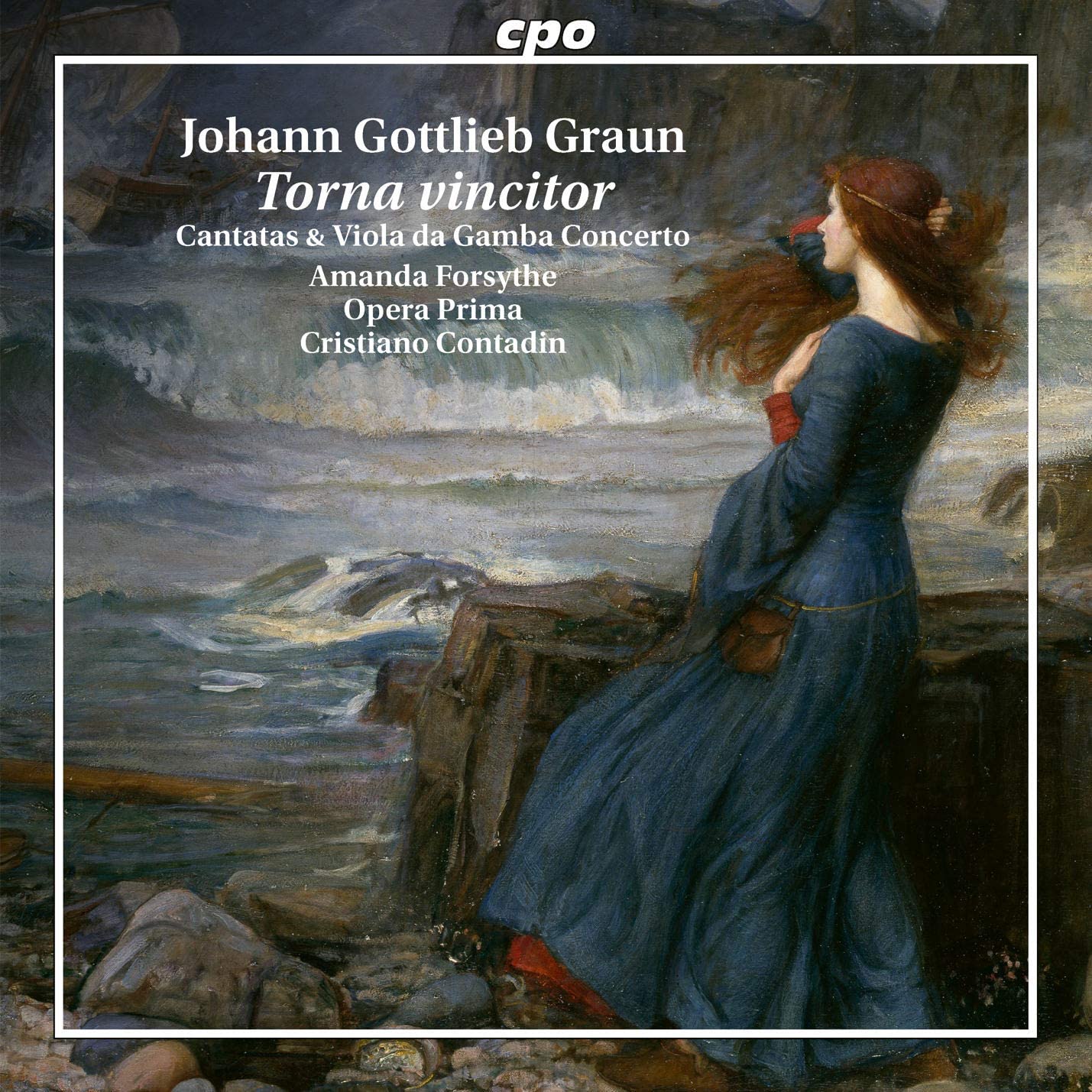
Cantatas & Viola da Gamba Concerto
Amanda Forsythe soprano, Opera Prima, Cristiano Contadin
78:26
cpo 555 284-2
Click HERE to buy this on amazon.co.uk
There were three brothers Graun that became musicians, although only Johann Gottlieb (1702/3-1771) and Carl Heinrich (1703/4-1759) became significant composers. Both served Frederick the Great at Potsdam, J G as leader of Berlin orchestra from 1740, while C H became Kapellmeister in the same year. Today C H Graun is much the better known largely due to his great success in Berlin as an opera composer, a genre in which his brother showed no interest in competing. Otherwise, the closely paralleled careers of the Grauns have caused musicologists not inconsiderable difficulties as to attribution of their instrumental works.
One group, however, that is not in dispute are the works Johann Gottlieb wrote involving the viola da gamba. He probably first discovered an interest in the instrument during his time as orchestral leader at Merseburg in the 1720s, where he came into contact with the gambist and violinist Hertel. However, it seems likely that the greatest influence on Graun’s attachment to the gamba was the virtuoso Ludwig Christian Hesse, whose father had studied with Marais and Forqueray in Paris. Hesse became a leading figure in the musical entourage of the Berlin court, where he worked alongside Graun from 1740 until 1761, presumably the period from which the majority of the former’s 27 known gamba works date.
The present CD includes three of these works, two large-scale cantatas for soprano, viola da gamba and strings and a three-movement Concerto in A minor, a work that has also been recorded by the great Italian gambist Vittorio Ghielmi (Astrée). The cantatas sung by the American soprano Amanda Forsythe are premiere recordings. Their texts are by Metastasio and like the operas of his brother (who set several of the great poet’s librettos) totally Italian in style. Both owe much to the pastoral movement, the first, ‘O Dio, Fileno’, concerning the laments of the shepherdess left by her lover to go to war, the oft-employed metaphor comparing love and war fully exploited in the long accompanied recitative that lies at the heart of the cantata. The enchanting ‘Già la sera’ takes a lighter look at love, as the lover tries to entice his Nice to leave the fields and live with him on the seashore, his enticements articulated in two arias which describe the alluring charms of eventide on the shoreline. Again they surround a long central accompagnato in which Nice is told she can become both ‘shepherdess and a fisher girl’. The needs to involve the concertante role for gamba and the fact that arias are in fully developed da capo form gives them an expansive scope, the first of the former work alone lasting for over 14 minutes. The writing for gamba, especially in ‘O Dio, Fileno’,
is extremely demanding, featuring rapid passagework and virtuoso polyphonic chordal writing. Perhaps its most appealing contribution comes in the opening aria of ‘Già la sera’, where voice and gamba work in sympathetic imitation to delightful effect.
The A-minor Concerto displays some of the nervous energy associated with Empfindsamkeit and also features much bravura writing for the gamba. In the outer movements, an opening orchestral statement is taken up by the gambist, its themes developed by the soloist in passaggi, chordal counterpoint and so forth. The central Adagio plays with ambiguity by alternating major and minor. It’s a moderately appealing work, less enticing here than in Ghielmi’s more characterful performance. Amanda Forsythe has a bright, pure soprano capable of agility and also sustaining cantabile lines with assurance, but it is difficult to avoid the feeling that she might have been heard to greater advantage in a less resonant acoustic than that provided by what sounds to be a large hall in the wonderful 16th century Villa Bolasco at Castelfranco in the Veneto. The long reverberation period allows the voice to spread uncomfortably in the upper range, but even making allowances for that her performances fall some way short of ideal. Passaggi and ornamentation are too frequently articulated without depth and far too little attention has been paid to diction and interpreting the text, though ‘Già la sera’ is not without the merit of generalized appeal and includes some impressive mezza voce singing. An interesting disc, then, but not an essential one.
Brian Robins

Ascioti, Baráth, Lombardi Mazzulli, Enticknap, Sacchi, Accademia Bizantina, Ottavio Dantone
160:46 (2 CDs in a single jewel case with booklet in a cardboard sleeve)
cpo 555 309-2
(Innsbruck Festival 2019)
Click HERE to buy this on amazon.co.uk
Venetian opera of the second half of the 17th century was marked by a remarkable flexibility of form involving recitativo cantando (sung recitative of the type familiar from the operas of Monteverdi) arioso and aria, the last often in strophic form. Frequently all three were seamlessly integrated and alternated to create fast-moving action involving both serious and comic episodes in which text was rarely subject to all but a minimal amount of repetition. Even more than Gluck’s so-called ‘reform’ operas, Venetian opera came close to realising a prototype of Wagner’s ideal of the Gesamtkunstwerk over 200 years before he formulated it.
Although many composers were active in Venice and beyond during the period, two names in particular stand out: those of Cavalli and Cesti. Of the two Cavalli is today by far the better known, a number of his operas have been revived in more recent times. Pietro Antonio Cesti remains a more shadowy figure, this despite having composed two of the most successful operas of the entire century, Orontea and La Dori. His relative obscurity may at least in part be accounted for because his greatest successes were composed not for Venice – thereby leaving him less explored by writers on Venetian opera – but Innsbruck, where he served the Archduke Ferdinand Karl from 1652 until 1657, and Vienna, where he was put in charge of theatre music in 1666. Both Orontea and La Dori date from the Innsbruck period, premiered in 1656 and 1657 respectively, but both became widely performed throughout Italy, La Dori achieving at least 30 productions by the 1680s.
2019 marked the 350th anniversary of the death of Cesti, so for the Innsbruck Early Music Festival to, as it were, bring La Dori home for that year’s edition was a particularly felicitous idea, the results of which are now available on this set. I was fortunate enough to be there, happily one of the most exhilarating productions of a 17th opera I’ve yet to see, sympathetically staged, with outstanding lighting, and sumptuously and colourfully costumed, in keeping with its being set in Babylon. Quite apart from much outstanding music, La Dori has the advantage of a splendidly varied libretto of high literary standard by Giovanni Filippo Apolloni. The story is highly complex, involving an arranged dynastic marriage that is very nearly foiled multiple times both in the prehistory of the plot and during the course of the opera itself. At breath-taking pace we are taken through a series of events involving mistaken identity, disguise, love intrigues and comic interludes, the latter mostly involving that stock character of Venetian opera, the old nurse Dirce, a role sung here with comic relish by tenor Alberto Allegrezza. Cesti’s music runs a wide gamut between tuneful dance-like arias in triple time to ravishingly sensual love music and near-tragic solo scenas, sometimes in close juxtaposition. At the pivotal point in act 2 Prince Oronte, still seeking his Dori, but having been convinced she is dead, dictates to the slave Ali (Dori in disguise) a letter to Arsinoe, the woman it has been arranged he will marry in the stead of Dori. It is a poignant scene, handled by Cesti with sensitivity and consummate dramatic skill and beautifully sung and vocally acted by Rupert Enticknap (Oronte) and Francesca Ascioti (Dori/Ali).
In keeping with the minimal instrumental forces customarily required for Venetian opera, La Dori is scored for continuo with two violins, whose role is near-exclusively confined to ritornellos. Ottavio Dantone has opted for a rather more generous orchestration, with three first and three second violins at times joined by recorders and a rich continuo group that includes the anachronistic addition of harp and chamber organ in addition to the expected bass strings, theorbos and harpsichords. Notwithstanding the continuo is deployed with such sensitivity and musicality that anything but the mildest censure is stilled, particularly in the face of direction that captures the essence of the work with unerring empathy and a thrilling sense of theatre. Dantone’s insistence on his singers devoting unusual attention to words is especially apposite in text-driven operas like La Dori and bears fruit in the vivid declamation in recitative and beautiful expressed Italian in cantabile music. His entire cast in fact does him credit. Emőke Baráth’s Tolomeo/Celinda (a woman playing a man disguised as a woman – I did warn you!) is sung with complete tonal security, while soprano Francesca Lombardi Mazzulli is a touching and impressive Arsinoe. The smaller roles are all exceptionally well taken. My only caveat is that I would have liked to have heard more ornamentation and for what is heard to have been more stylish and clearly articulated. That said this is one of the most musically and dramatically satisfying recordings of a Venetian opera available. La Dori deserves to be far more widely known; its pace, colour and variety would make it an ideal opera for Glyndebourne.
Brian Robins

Manuel Staropoli recorder/flute, Gioele Gusberti cello, Manuel Tomadin harpsichord/organ
71:32
Brilliant Classics 95517
Click HERE to buy this on amazon.co.uk
Telemann was never one to shy away from offering flexible performance possibilities and this set of partitas displays just this, being his second foray into the world of publishing (Die Herbst Messe/Autumn Fair Frankfurt) in 1716, seeking to appeal to specific players. Initial suggestions in the Preface state “for violin, flute, or keyboard” but *Besonders aber vor die Hautbois! (*”especially for the oboe!”) This is most often how these “light and singing” pieces are explored, openly aimed at four of the finest oboists of the age: Francois Le Riche, J. C. Richter, P. Gloesch and M. Boehme. When Camerata Köln came to record these for cpo 999 497-2 in 1996, they opted for a clever selection of instruments including oboe, offering a fine sonorous spectrum.
This latest recording makes use of three gauges of recorder, including the soprano, and flute to negotiate the partitas in their original order. In the first and fifth partitas, the organ comes into the continuo group with cello, adding a less familiar sonority within these familiar works. I would have liked to have heard the C minor or G minor works with this instrument for added gravitas. The performances of these “light and cantabile” partitas on this recording, opening with B flat major’s “Con affetto” pulses along, yet, with some oft rather strident recorder tones and flickering flashes of organ, with passing interjections of cello, it feels blithe yet somehow a tad perfunctory from the very opening bars, which on oboe comes over much subtler and far more comfortably expressive. The lovely lilting “Dolce” (which the composer cunningly re-crafted into the aria Kehre wieder, mein Vergnügung from Die Satyren in Arcadien), is very hastily dispatched! For the next three partitas, the harpsichord is deployed, and one senses a return to more familiar modes of accompaniment and slightly better articulation in the solo instrument, yet somewhat missing are the more “rounded” legato tones heard on many other recordings. This tidy, punctilious approach makes for just a hint of a blasé effect with fleeting shrillness creeping in. The organ in the fifth partita does feel much better, paired here with the flute. Some slightly bolder phrasing from the solo instrument may have lifted these florid passages, which the continuo element do handle well! Many eminent oboists have demonstrated their prowess on these well-crafted works with vivacity, engaging clarity, and yes, at times warmly “vocal” tones; other instrumentalists must strive for this sense of responsive zeal and feel for the sensual, expressive scope. Having heard easily more a dozen versions, especially on oboe (Paul Dombrecht, Hansjörg Schellenberger). Oddly enough, some of the qualities missing in the execution of these partitas were to be found in the D major cello sonata which closes the disc. In conclusion, wouldn’t be my run-to set and might sit somewhere halfway in a fairly largish pile of previous recordings.
NB: Very spurious/erroneous musicology on Page 7 regarding the orchestral versions of these partitas needs some serious revision; I have been in touch with the CD Company.
David Bellinger
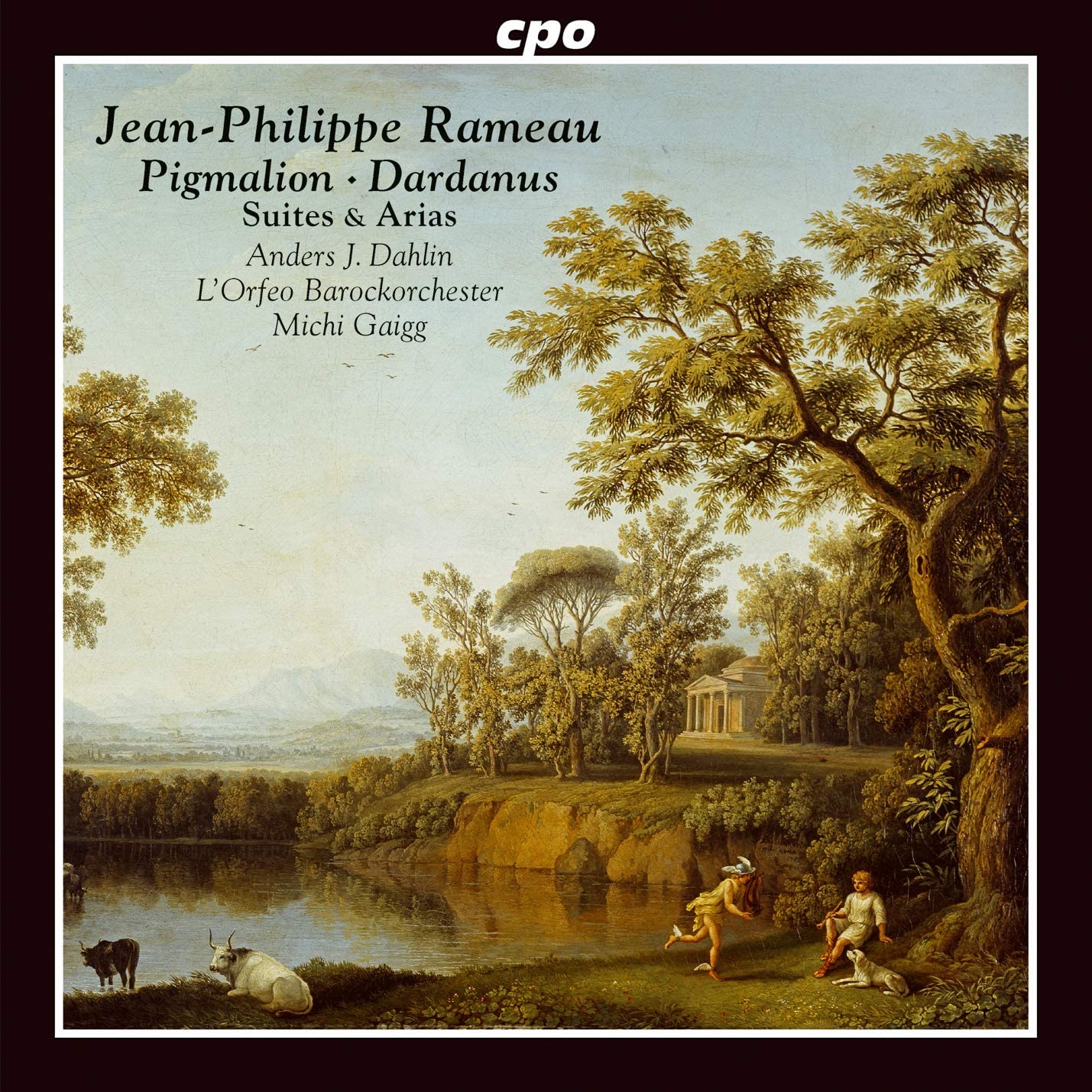
Suites & Arias
Anders J. Dahlin Haute-Contre, L’Orfeo Barockorchester, Michi Gaigg
65:51
cpo 555 156-2
Click HERE to buy this on amazon.co.uk
This is a recording of conveniently sliced portions of Rameau to showcase the voice of the Swedish tenor, Anders J. Dahlin, and who wouldn’t wish to spend an hour lost in some fine French Baroquery when delivered so reverently and sensuously, done to a T… bien cuit!
Pigmalion – being that famous story of the sculptor falling for his statue with the help of Cupid (L’Amour) – was Rameau’s first outing with the “Acte de Ballet” in 1748. He must have enjoyed some success, for he wrote another seven between 1748-1754. In this version, the other characters, (including the Statue!) and the choral interjections have been removed to allow the eponymous hero to take centre stage. There’s much to admire with this slightly truncated version; the French musical idioms are very well-observed and delivered with the keenest charm and cogent skills. Both the dynamic orchestral shading and their lilting supportive tones are a delight to hear, and Dahlin himself dramatically creates the aspects of infatuation and afflicted pygmalionism. Even curtailed, it is a fine soupçon of the emotive dramaturgical effects Rameau could conjure from his vivacious, sparkling musical esprit.
Track 3, which is effectively the Graces teaching the statue to dance, echoes some of Rebel’s Caracteres de la danse; the whole piece closes with a sprightly Contradanse (Ballet general….au son du tambourin?). After modest initial success, Pigmalion was repeated in 1750s onwards and revived in 1781! It testifies to Rameau’s fecundity of ideas during a prolific period of activity.
Dardanus was staged three times, in 1739, 1744 and 1760. Drastic revisions were made, with the result that there are really two different operas. The extensive Ouverture et suite de danses (Track 20) from Dardanus featured on an Amati recording by the same ensemble in 1993; it is always fascinating to compare and while the Amati perhaps languished in those special “moments to savour”, strikingly, the closing Chaconne has a longer unfurling at 4:30 compared to only 4:07 here.
It is mighty difficult to cherry-pick from such works of transformative, scenic musical genius, especially when the range of options is so broad; this said, a happy “cross-section” has been made and played with verve and vigour. Dahlin displays pieces from salient moments in this Tragedie en Musique, yet perhaps something might have been included from one of the earlier acts too? This is, overall, an admirable display of some of Rameau’s moments of drama; touching key notes and reaching for those elegant, cheery moments of guaranteed infatuation.
David Bellinger
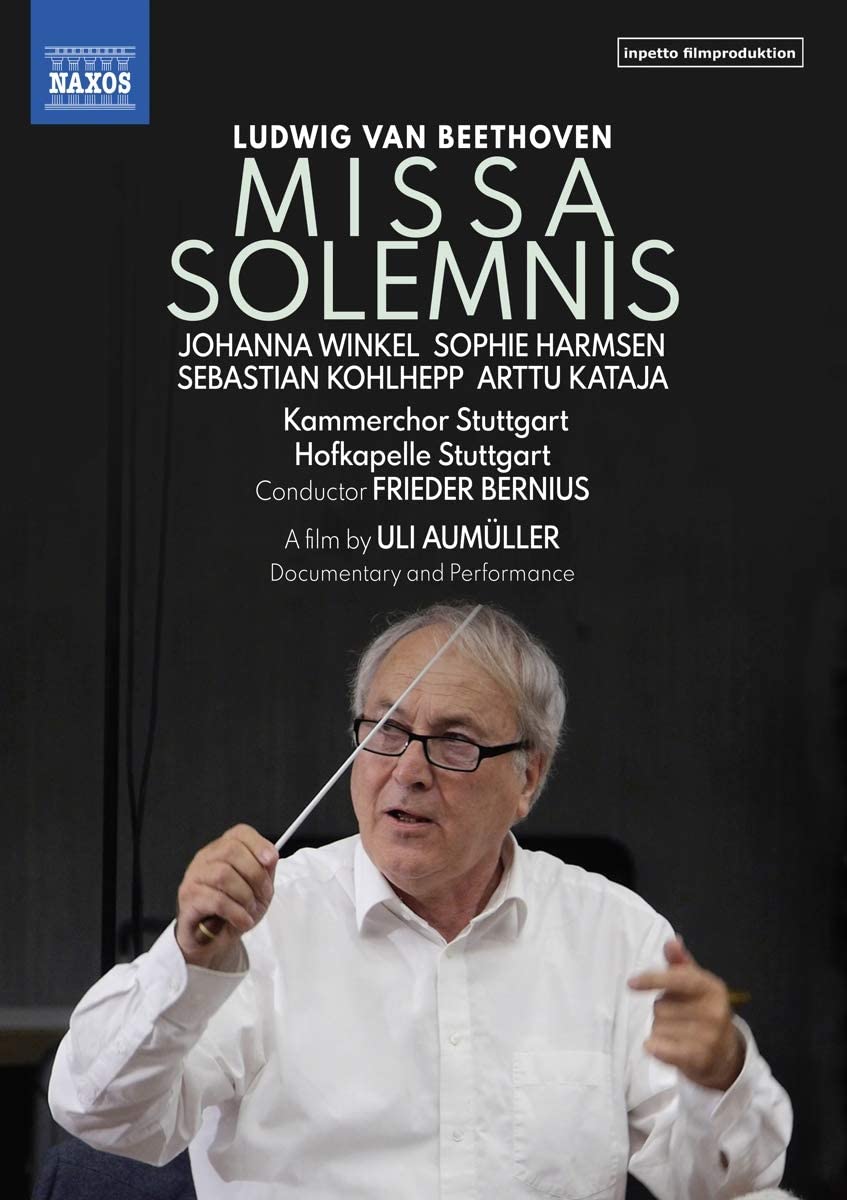
Johanna Winkel, Sophie Harmsen, Sebastian Kohlhepp, Arttu Kataja, Kammerchor Stuttgart, Hofkapelle Stuttgart, Frieder Bernius
Documentary and Performance
71:00 (music), 60:00 (documentary)
Naxos 2.110669
Click HERE to buy this on amazon.co.uk
How do we approach the Missa Solemnis in this Beethoven year, 2020? It is not an easy question to ask of a work that is so multi-faceted, a huge structure that both storms the heavens, as if shaking a fist at fallen mankind, and yet also provides that same mankind with the solace and comfort of the Elysian fields. Anton Schindler, Beethoven’s first biographer, noted that from the start of the Mass’s long gestation period (1818-1823) Beethoven was in a condition of ‘oblivion of everything earthly’. The concept of a large-scale celebratory Mass for the elevation of his royal pupil Archduke Rudolf to cardinal and archbishop in Cologne Cathedral – an event long since over by the time the Mass was completed – had been transcended by 1823. I confess to finding it difficult to provide firm answers to the question posed in my opening sentence.
Some help is certainly provided by this new Naxos release featuring a film of a recording made in October 2018 at Alpirsbach Abbey, Baden-Würtemberg. Not only do we see film of the recording itself, but also a fascinating hour-long documentary that includes valuable insights into the work and Frieder Bernius’s approach to it. For that reason, I would recommend watching the documentary before viewing the performance. Bernius is, of course, a long-established conductor and was the founder of the Kammerchor Stuttgart, whose 50th anniversary is also celebrated by this issue. One of the most interesting features of the film is the way in which Bernius works with his choir, often taking just a couple of choristers to give them individual tuition on the work in hand. Even more compelling is to observe that Bernius’s approach, inspired by his many years of working on earlier choral music, is text-based, the results of his insistence on detailed working on such matters as pronunciation and articulation clearly evident in the final performance. In addition to the interviews and rehearsal clips, there are some fascinating archival clips of Bernius at work with earlier incarnations of the Kammerchor, along with interviews with some of the present performers.
Moving to the performance itself it is clear from the outset of the Kyrie that Bernius knows precisely what he wants. Taken at a measured tempo, the music moves with calm assurance, while the solo entries announce a fine young quartet that throughout impresses particularly in the many ensemble passages, obviously encouraged by Bernius to make the most of the madrigalian textures with which the work abounds. Christe is beautifully managed, though the timpani and brass don’t quite achieve unanimity in the quiet transition back to Kyrie. The Gloria, too, sets out at a well-judged tempo, avoiding the feeling of being pushed. Indeed, the whole, vast movement is unfolded by Bernius like an epic poem. ‘Et in terra’ brings a moment of wondrous stasis in the midst of powerful drive, while the prayerful ‘Gratias’ is another memorably placid interlude succeeded by some splendidly incisive orchestral playing in the lead back to the opening tempo and ‘Domine Deus’. And it is worth mentioning at this point that although the period-instrument Hofkapelle Stuttgart is hardly the most illustrious orchestra to undertake the Missa Solemnis, its playing throughout is excellent, with many distinguished moments coming from its wind section. The overall grandeur of the movement is brought to a triumphant peroration in the final doxology.
Credo opens as powerful affirmation, the contrapuntal passages once again luminescent in their clarity of detail. The start of ‘Et incarnatus’ finds the choral tenors handling this key moment with a real sensitivity complimented by glinting high wind, another treasurable moment. The stabbing pain of ‘Crucifixus’ is tellingly conveyed, as is the mesmerizingly lovely outcome at ‘et sepultus est’.
Beethoven’s ‘Sanctus’ is not the exultant triple cry of so many settings but a reverential moment on bended knee in contemplation of God’s glory. The choral sopranos have a rare ragged moment of ensemble at the exposed entry on ‘Osanna’, but in general cope with Beethoven’s wickedly high tessitura very capably. The high violin solo a little later is very well played. The opening of Agnus Dei provides a fine moment for bass Arttu Kataja, to distinguish himself and lead his three colleagues into a gloriously sung exposition, while the militaristic flourishes (first introduced into an Agnus Dei by Haydn in his Missa in tempore belli) provide thrilling moments of dramatic extroversion.
As I hope is clear from the foregoing Bernius’s Missa Solemnis impresses by dint of its total integrity. It may not be the most imposing or the most dramatically enthralling version on record, but few will not be moved and touched by it. ‘From the heart, may it go to the heart’, wrote Beethoven of his monumental work. Here that mission is unquestionably accomplished.
Brian Robins
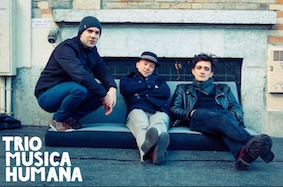
If you happen to be lucky enough to live near Vézelay in France, the Cité de la Voix would like to welcome you back into concert life during the weekend of 18-19 September.
In a free concert on the Saturday evening Ensemble Agamemnon brings a Mediterranean touch to a variety of music including Italian cantatas, while (following another free early recital, this time by Trio Musica Humana) Jean Tubéry directs guest soprano Camille Joutard and his ensemble La Fenice in “Musique pour la Monica”, tracing the varied use of a popular tune in the baroque period.
For details of the full season, click this link: BRO_AUTOMNE_2020_web.

Camerata Köln
56:24
cpo 555 321-2
TWV43: C2, D6, D8, F6, G6, G10, 51:D6
Click HERE to buy this on amazon.co.uk
Hats off and “Congrats” to Camerata Köln for their tireless dedication to this repertoire, and here now “looping the loop” with a victory roll, making a super “round-up” of the remaining Telemann works with winds. To only a few with impeccable tracking skills or alert discographic memories, perhaps requisite musicological insights, will some of these pieces be familiar. For the two solo horn works (TWV43:F6 And D8), the fine bookends to this CD, along with the Concerto for oboe, violin and viola in D, this is surprisingly just their second outing! The ensemble’s name is already a by-word for quality of tonality and musicality; these seasoned players shine with an effortless fluidity and captivating melodic charms, supported by the marvellously nimble bassoonist, Marita Shaar-Faust, and resplendent horn(s) of Ulrich Huebner; as he deploys two natural horns on this recording, opening with the Nürnberg instrument of 1720, and ending with a copy of a J. W. Haas instrument. The opening F major work (ca. 1715?) with a brisk élan and great dialogue has some passages recalling the Musique de Table in passing, then the following movements seem to nod towards music found in the wind quintets (TWV44); did it have a previous life as a quintet? It is a curious, yet splendidly engaging, piece with a tail-end Giga. Next comes the jaunty D major concerto for oboe, violin and viola; Hans-Peter Westermann sails through it with his polished, responsive musicianship making the music fly away. In the C major work, the soloists weave a beguiling spell redolent of other Telemann quartets (for example, 43:h3). The playing of the TWV43:G6 is exemplary and should be relished by all! The work listed as TWV43:D6 has in the past been attributed to Handel, and hand on heart or ear, I do detect certain Handelian phrases in the first and third sections (Con Contento and Largo) but the other movements seem much more akin to Telemann’s musical mannerisms, which do seem to re-assure and settle residual ambiguities. Amusingly the unphotographed players of bassoon and horn really make their instrumental contributions felt.
Rounding off this perfect “round-up” a familiar piece, and one less so; the G major work for flute and two gambas is a real tour de force; first on CD in 2001 (Ars Antigua), it is fabulously contoured with superb opening and finishing éclat! I’m amazed this hasn’t become more widely performed, yet I do recall a Belfast concert when the audience clapped after the dazzling Vivace! The closing horn work is another curious hybrid concerto/quartet, with hunting calls bursting into the second movement, the violins having previously woven the sensual introduction alone; adding intrigue, the movement’s theme has a most noticeable closeness to one in a Leopold Mozart horn concerto. The Menuet does feel a tad stiff for Telemann, and yet you could imagine it played during a Frankfurt Collegium Musicum gathering.
In conclusion, this is a neatly gathered and wonderfully played collection of works by the finest musicians, looping the loop!
David Bellinger

Medieval organs composed – Decomposed – Recomposed
Catalina Vicens
Timings not available (2 CDs)
Consouling Sounds SOUL0139
Click HERE to buy this on amazon.co.uk
Catalina Vicens sets out in these two CDs to produce something rather different from the usual early keyboard recording. She avoids the small amount of surviving keyboard repertoire and, instead, gives us a selection of early vocal music from Hildegard of Bingen to Henry VIII, passing through some Notre Dame Organum, the Italian Ars Nova, John Dunstable and Heinrich Isaac. This is supplemented by a range of contemporary music by Prach Boondiskulchok, Carson Cooman, Ivan Moody, Olli Vitaperko and Vicens herself. She uses a number of modern copies of small Medieval organs by Winold van de Putten and others, as well as two historic instruments: that in the Andreaskirche in Ostönnen from c. 1425 (reckoned to be the oldest still playable) and the other from 1531 in the Krewerd’s Mariakerk. The sounds she produces are equally not always those which might be expected: the organ pipes can resemble Japanese flutes, panpipes or foghorns, with flutter-tonguing and lots of drones. Other noises sometimes intrude and have deliberately not been edited out. The most experimental pieces are the two by Boondiskulchok and that by Moody, which produce some fascinating sounds. Vicens’ own music generally lies closer to early models, though with some experimental resonances too. Overall, there is an affinity between the Medieval and contemporary tracks which allows a seamless movement between them, making the whole production something of an extended meditation with a strong sense of improvisation. It has grown on me and is certainly a worthwhile undertaking, with excellent recording quality. My only gripe is with the lack of information about instruments and music in the beautifully designed booklet – or on the website to which the listener is directed. We don’t even get timings for the tracks which vary considerably in length. The musicologist in me wished for more details but perhaps the recording is aimed at a different kind of audience!
Noel O’Regan
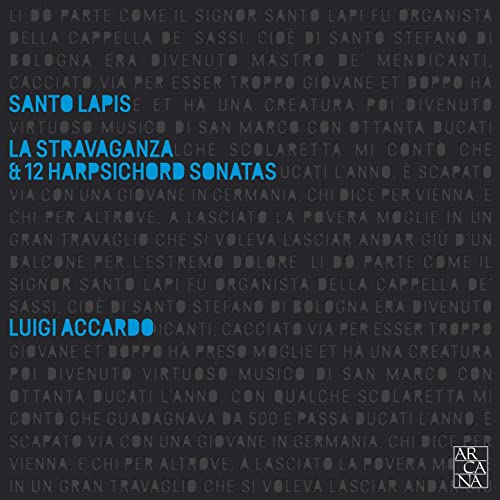
Luigi Accardo harpsichord
61:33
Arcana AD107
Click HERE to buy this as an mp3 on amazon.co.uk
Santo Lapis (c.1699-1765) led a much-travelled life, from his birthplace in Bologna via Venice, Vienna and the Netherlands to England in 1757, also taking in Scotland and Ireland during the 1760s. He seems to have been something of a libertine and a jobbing musician who carried on a successful freelance career, particularly in opera production. Not much of his music survives but the sonatas on this recording were published in The Hague in 1742, while the extended three-movement La Stravaganza followed in 1757. The sonatas follow the bipartite Scarlattian model and, while lacking the inspiration of their models, they are nevertheless entertaining pieces, with some quirky corners and pleasing melodies. The middle movement of La Stravaganza is a Handelian fugue which works very well; the finale of that work, on the other hand, is a rather dull Menuet with variations, which might have come more alive here with a faster tempo. Lapis does rely a lot on sequential figuration, presenting a challenge to the performer to keep the music fresh. Accardo responds well to this challenge and plays with commitment and sparkle, and a flexibility that just occasionally slips into unevenness in the rhythm. He plays on a copy of an anonymous early 18th-century German harpsichord by Keith Hill. The recording is certainly worth listening to as an evocation of the sort of Italian-style music heard all over Europe in the mid-18th century.
Noel O’Regan